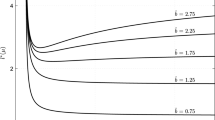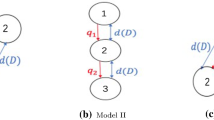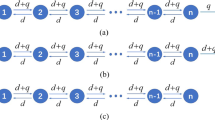Abstract
We consider a two-species competition model in a one-dimensional advective environment, where individuals are exposed to unidirectional flow. The two species follow the same population dynamics but have different random dispersal rates and are subject to a net loss of individuals from the habitat at the downstream end. In the case of non-advective environments, it is well known that lower diffusion rates are favored by selection in spatially varying but temporally constant environments, with or without net loss at the boundary. We consider several different biological scenarios that give rise to different boundary conditions, in particular hostile and “free-flow” conditions. We establish the existence of a critical advection speed for the persistence of a single species. We derive a formula for the invasion exponent and perform a linear stability analysis of the semi-trivial steady state under free-flow boundary conditions for constant and linear growth rate. For homogeneous advective environments with free-flow boundary conditions, we show that populations with higher dispersal rate will always displace populations with slower dispersal rate. In contrast, our analysis of a spatially implicit model suggest that for hostile boundary conditions, there is a unique dispersal rate that is evolutionarily stable. Nevertheless, both scenarios show that unidirectional flow can put slow dispersers at a disadvantage and higher dispersal rate can evolve.


Similar content being viewed by others
References
Ballyk M, Dung L, Jones DA, Smith H (1998) Effects of random motility on microbial growth and competition in a flow reactor. SIAM J Appl Math 59(2):573–596
Belgacem F, Cosner C (1995) The effects of dispersal along environmental gradients on the dynamics of populations in heterogeneous environment. Can Appl Math Quart 3:379–397
Berestycki H, Diekmann O, Nagelkerke CJ, Zegeling PA (2009) Can a species keep pace with a shifting climate? Bull Math Biol 71(2):399–429
Berestycki H, Rossi L (2008) Reaction–diffusion equations for population dynamics with forced speed I—the case of the whole space. Discrete Contin Dyn Syst 21(1):41–67
Boldin B (2008) Persistence and spread of gastro-intestinal infections: the case of enterotoxigenic Escherichia coli in Piglets. Bull Math Biol 70(7):2077–2101
Cantrell RS, Cosner C (2003) Spatial ecology via reaction–diffusion equations. In: Series in mathematical and computational biology. Wiley, Chichester
Cantrell RS, Cosner C, Lou Y (2006) Movement towards better environments and the evolution of rapid diffusion. Math Biosci 204:199–214
Cantrell RS, Cosner C, Lou Y (2007) Advection mediated coexistence of competing species. Proc R Soc Edinb 137A:497–518
Cantrell RS, Cosner C, Lou Y (2010) Evolution of dispersal and ideal free distribution. Math Biosci Eng 7:17–36
Chen XF, Hambrock R, Lou Y (2008) Evolution of conditional dispersal: a reaction–diffusion–advection model. J Math Biol 57:361–386
Chen X, Lam K-Y, Lou Y (2012) Dynamics of a reaction–diffusion–advection model for two competing species. Discrete Contin Dyn Syst A 32:3841–3859
Chen X, Lou Y (2008) Principal eigenvalue and eigenfunctions of an elliptic operator with large advection and its application to a competition model. Indiana Univ Math J 57:627–657
Cobbold C, Lutscher F (2013) Mean occupancy time: linking mechanistic movement models, population dynamics and landscape ecology to population persistence. J Math Biol
Cosner C, Lou Y (2003) Does movement toward better environments always benefit a population? J Math Anal Appl 277:489–503
Dahmen KA, Nelson DR, Shnerb NM (2000) Life and death near a windy oasis. J Math Biol 41:1–23
Desai MM, Nelson DR (2005) A quasispecies on a moving oasis. Theor Popul Biol 67:33–45
Dieckmann U (1997) Can adaptive dynamics invade? Trends Ecol Evol 12:128–131
Dockery J, Hutson V, Mischaikow K, Pernarowski M (1998) The evolution of slow dispersal rates: a reaction–diffusion model. J Math Biol 37:61–83
Hambrock R, Lou Y (2009) The evolution of conditional dispersal strategies in spatially heterogeneous habitats. Bull Math Biol 71(8):1793–1817
Hastings A (1983) Can spatial variation alone lead to selection for dispersal? Theor Popul Biol 24:244–251
Hsu S, Smith H, Waltman P (1996) Competitive exclusion and coexistence for competitive systems on ordered Banach spaces. Trans Am Math Soc 348:4083–4094
Huisman J, Arrayás M, Ebert U, Sommeijer B (2002) How do sinking phytoplankton species manage to persist. Am Nat 159:245–254
Hutson V, Lou Y, Mischaikow K (2002) Spatial heterogeneity of resources versus Lotka–Volterra dynamics. J Diff Equ 185:97–136
Kolokolnikov T, Ou C, Yuan Y (2009) Profiles of self-shading, sinking phytoplankton with finite depth. J Math Biol 59(1):105–122
Lam K-Y (2011) Concentration phenomena of a semilinear elliptic equation with large advection in an ecological model. J Diff Equ 250:161–181
Lam K-Y (2012) Limiting profiles of semilinear elliptic equations with large advection in population dynamics II. SIAM J Math Anal 44:1808–1830
Lam K-Y, Lou Y (2013) Evolution of conditional dispersal: Evolutionarily stable strategies in spatial models. J Math Biol (doi:10.1007/s00285-013-0650-1)
Lam K-Y, Ni W-M (2010) Limiting profiles of semilinear elliptic equations with large advection in population dynamics. Discrete Contin Dyn Syst A 28:1051–1067
Leroux SJ, Larrive M, Boucher-Lalonde V, Hurford A, Zuloaga J, Kerr JT, Lutscher F (2013) Mechanistic models for spatial spread of species under climate change. Ecol Appl
Lieberman GM (1996) Second order parabolic differential equations. World Scientific Publishing, Singapore
Lin AL, Mann BA, Torres-Oviedo G, Lincoln B, Käs J, Swinney HL (2004) Localization and extinction of bacterial populations under inhomogeneous growth conditions. Biophys J 87:75–80
Lutscher F, McCauley E, Lewis MA (2006) Effects of heterogeneity on spread and persistence in rivers. Bull Math Biol 68(8):2129–2160
Lutscher F, McCauley E, Lewis MA (2007) Spatial patterns and coexistence mechanisms in rivers. Theor Popul Biol 71(3):267–277
Maciel GA, Lutscher F (2013) How individual movement response to habitat edges affects population persistence and spatial spread. Am Nat
McKenzie HW, Jin Y, Jacobsen J, Lewis MA (2012) \(R_0\) analysis of a spatiotemporal model for a stream population. SIAM J Appl Dyn Syst 11(2):567–596
Metz JAJ, Mylius SD, Diekmann O (2008) When does evolution optimise? Evol Ecol Res 10:629–654
Murray JD, Sperb RP (1983) Minimum domains for spatial patterns in a class of reaction diffusion equations. J Math Biol 18:169–184
Ovaskainen O, Cornell SJ (2003) Biased movement at a boundary and conditional occupancy times for diffusion processes. J Appl Prob 40(3):557–580
Potapov AB, Lewis MA (2004) Climate and competition: the effect of moving range boundaries on habitat invasibility. Bull Math Biol 66(5):975–1008
Protter MH, Weinberger HF (1984) Maximum principles in differential equations, 2nd edn. Springer, Berlin
Smith H (1995) Monotone dynamical systems. In: Mathematical surveys and monographs, vol 41. American Mathematical Society, Providence
Speirs DC, Gurney WSC (2001) Population persistence in rivers and estuaries. Ecology 82(5):1219–1237
Strohm S, Tyson R (2012) The effect of habitat fragmentation on cyclic population dynamics: a reduction to ordinary differential equations. Theor Ecol 5(4):495–516
Vasilyeva O (2011) Modeling and Analysis of Population dynamics in advective environments. PhD thesis, University of Ottawa
Vasilyeva O, Lutscher F (2011) Population dynamics in rivers: analysis of steady states. Can Appl Math Q 18(4):439–469
Vasilyeva O, Lutscher F (2012) Competition of three species in an advective environment. Nonlinear Anal RWA 13(4):1730–1748
Vasilyeva O, Lutscher F (2012) Competition in advective environments. Bull Math Biol 74:2935–2958
Acknowledgments
We thank Odo Diekmann and two anonymous reviewers for their thorough reading of the manuscript and for excellent suggestions. YL was supported by the NSF Grant DMS-1021179 and has been supported in part by the Mathematical Biosciences Institute and the National Science Foundation under grant DMS-0931642. FL was supported by an NSERC Discovery grant and an Early Researcher Award from the MRI, Ontario. A visit of YL at the University of Ottawa was supported by the Mprime Network on Biological Invasions and Dispersal Research (see http://www.unb.ca/bid/bid.php).
Author information
Authors and Affiliations
Corresponding author
Rights and permissions
About this article
Cite this article
Lou, Y., Lutscher, F. Evolution of dispersal in open advective environments. J. Math. Biol. 69, 1319–1342 (2014). https://doi.org/10.1007/s00285-013-0730-2
Received:
Revised:
Published:
Issue Date:
DOI: https://doi.org/10.1007/s00285-013-0730-2
Keywords
- Evolution of dispersal
- Advective environments
- Persistence
- Invasion analysis
- Reaction–diffusion–advection




